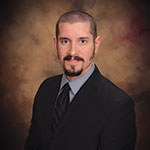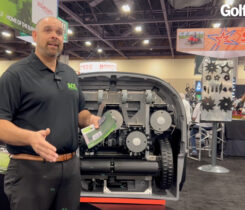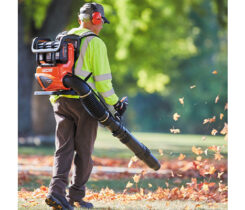Battery-powered equipment experts share tips, tricks for use
John Powers, director of product management for Echo, and Steven Johnson, regional sales manager for Smithco, sat down with Golfdom and answered our battery-powered questions
Golfdom: Do you have a good tip, something crews might not think of when they switch from gas-powered equipment to battery-powered?

John Powers
John Powers, Echo: What I have seen from end users, the way they use the equipment is they need to be a lot more disciplined about not running the equipment when they’re not actually cutting or doing the work. One of the things that some of the users are used to, if they’re used to running gas equipment, is they’ll feather the throttle, or they’re used to the unit essentially idling when they’re walking from one place to another. So, say if they’re trimming one area, they’ll do the trimming around a bush, and then if they’re used to using a gas unit, the unit idles as they walk to the next area. They need to be a lot more disciplined about not using the battery equipment, not using the charge in the battery, while they’re just walking from one place to another.
Golfdom: Is there anything “new” about battery-powered equipment that you want to share?
Powers: In general, battery technology, I would say the area that is most constantly evolving is capacity, which directly relates to what we were just talking about with run time. That’s an ever-evolving part of the technology. And that’s to solve the challenges that exist, not only in the outdoor power equipment industry but also in the automotive industry, another industry that uses lithium-ion batteries. They’re always looking for more energy density in the cells, which gives you more capacity, which gives you more run time. So, that’s kind of an ever-evolving part of it. I think that’ll probably continue for the foreseeable future.
Golfdom: Steven, you’ve worked for Smithco for a long time now, which produces a lot of gas-powered equipment for the golf and sports turf markets. Did you think in 2021 you’d be talking about Smithco’s battery-powered offerings?

Steven Johnson
Steven Johnson, Smithco: Back in 1994, when I started working for the company, we were the very first ones to come out with an electric-powered bunker rake, and it hit the ground running. There was a little bit of skepticism at first because everybody was used to gas-powered equipment, but I’ve seen the writing on the walls for renewable energy, for more cost-effective products. You’re looking at pennies on the dollar to operate electric units in lieu of what it costs to run your traditional combustion-style engines when you start figuring in fuels, oil changes, filters, all that fun stuff that has to be addressed monthly.
Golfdom: You know a lot of superintendents around the country. What are the ones who have started using battery-powered equipment telling you about the results?
Johnson: No. 1, superintendents love the fact that it’s quiet. They can take it out anytime they want. Courses are short on manpower when it comes to getting out and doing the day-to-day jobs. The ability to go out after golf has started, that’s extremely important to them. The other thing is just the maintenance side; they bring it back in, and they plug it in. We have on-board battery management systems that are in place with a 10-year warranty. So, that side of it instills a lot of confidence because most folks keep ahold of their bunker rakes for a good 10 years. A lot of that negativity (toward battery) came from standard lead-acid batteries. And they were looking at replacing them every four years. They don’t have to worry about that anymore.











